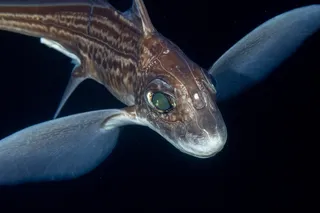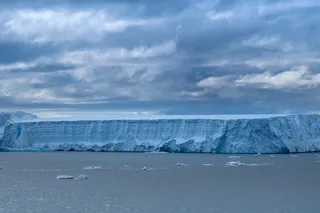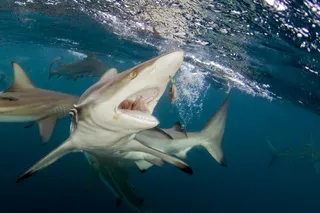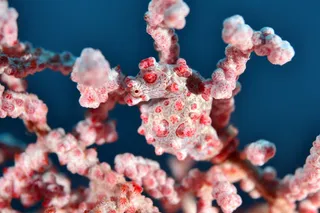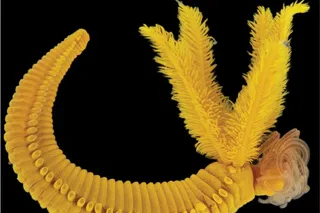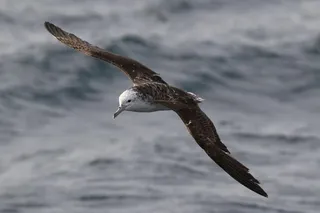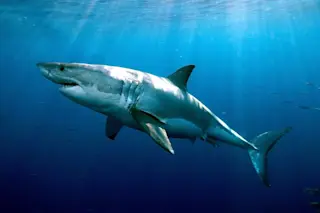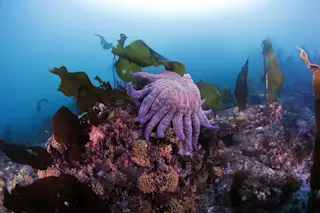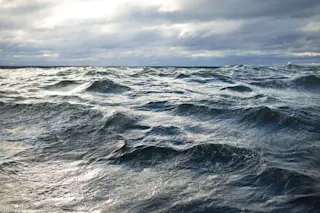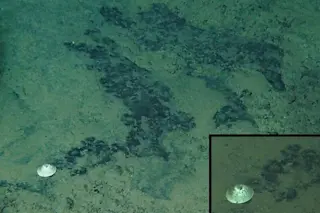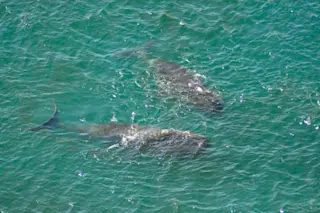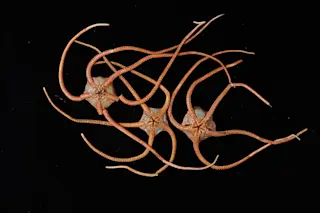What was going on that day, on and around the Atlantis II, could almost have been called boring. It was August 12, 1991. Aboard the ship, a research vessel operated by the Woods Hole Oceanographic Institution, were 42 people doing their daily chores, sleeping, or just waiting. There were another three people below the ship, inside a submersible whose inner diameter is six and a half feet, the size of a nice walk-in closet, except that this closet was separated from the sky and safety by 6,900 feet of Pacific water. This was routine. It was more routine than a space shuttle mission, certainly. Maybe it was as routine as flying an F-16. Cindy Lee Van Dover, who was piloting that day, claimed you were safer inside that submersible, Alvin, than in your car. After all, Alvin had made 2,427 dives over the past quarter century and no one had gotten seriously hurt. That day only one or two neophytes had stood on the fantail to watch the launch, and to see Alvin sink into the abyss, untethered, for the 2,428th time.
Inside the sub were Rich Lutz, a fortyish deep-sea biologist from Rutgers who was responsible for bringing everyone to that particular spot in the ocean, 100 miles off the coast of Oregon; Randy Hinderer, a former Navy diver and an Alvin pilot in training; and Van Dover, a biologist who just a year earlier had been elevated to the status of first scientist- pilot and first female pilot. For two hours that afternoon Van Dover and her passengers whirred along the seafloor at a knot or less. Lacking a precise map, they followed hunches. They drove up the muddy slope of a canyon, to a muddy summit, along a muddy ridge. Their purpose was to find clams. Lutz was looking for a clam bed that other oceanographers had discovered a few years earlier--a place where a rich colony of clams thrived on bacteria that thrived on gases seeping out of the sediments. But all he and Van Dover and Hinderer saw through their four-inch-wide portholes was mud: boring mud.
Sometime after four o’clock, just as their clamlessness was beginning to get frustrating, their priorities changed. Halfway through the dive the clams didn’t matter anymore, Lutz said later. Van Dover said: I was driving along this real gentle slope, and I wasn’t even using the lift propellers. Usually when the slope is gentle you don’t need them; the ski on the bottom of the sub just carries you along. Then it got a little steeper, and I went to turn the lift props on. And I saw that we weren’t lifting off the bottom. That’s when I started to think something was wrong. It was 4:28 P.M. when Van Dover’s voice, transmitted acoustically through 6,900 feet of water and reverberating tinnily from a loudspeaker on the top deck of the Atlantis, shattered the shipboard routine: I think we may be snagged on something, she said blandly.
Working in the deep sea is occasionally dangerous but always hard. Think about what it would be like to study our own world the way biologists must study the deep sea. Imagine a race of scientifically inclined space aliens. Having discovered Earth, they set out to understand the life on its surface. These unfortunate aliens, however, lack advanced tools of research. Their wispy bodies cannot withstand the crushing pressure of our atmosphere. It is utterly opaque to their eyes, which are sensitive only to a small range of wavelengths in the infrared. For want of a better idea, they decide to drag a large, sturdily framed net from their spacecraft as it cruises safely above the clouds.
The net first touches down one Friday evening in Paterson, New Jersey, where it clips a flagpole off the top of City Hall. Next it bounces through a high school football stadium, scattering fans and players without snaring a one; collects a pensioner hobbling along Main Street, as well as his cane; scoops through a backyard on Elm, where it picks up a picnic table, a clothesline bearing some exotic black undergarments, and a patch of lettuce with its associated groundhog. Finally it nearly comes to grief in a dark corner of the K mart parking lot, where the weight of a 1972 Chevy Nova and the teenagers in its backseat causes the net cable to groan audibly and prompts the aliens to quickly reel in their catch.
This was essentially the method used by deep-sea biologists in the century before Alvin was built.
The aliens’ first haul and the ones that follow are confusing, but not so confusing that the pages of their scientific journals are not soon filled with competing theories on the ecology and physiology of terrestrial organisms. In particular, the relation between the Nova and its primitive endosymbionts excites a raucous debate among physiologists. But everyone agrees on the limitations of the sampling technique. So the alien engineers come up with something different. They construct a pressure- resistant capsule of two-inch-thick kryptonite, called a subaerial, in which three aliens can descend to Earth’s surface, putter around for a few hours, and pick up any interesting thing they happen to bump into. The sub is a fabulous success. At last a few lucky aliens get to see Earth with their own infrared eyes. But because Earth’s surface is so vast and so poorly mapped, the aliens tend to return to the same places again and again; exploring the whole planet is beyond their means. The sites they prefer, besides Paterson, are Logan, Utah, and a suburb of Novosibirsk. In repeated visits to these sites they remove many organisms for laboratory study, in some cases depopulating whole neighborhoods. But they never quite manage to discover the Chinese.
This is essentially the method of studying deep-sea biology with Alvin.
The analogy is a little unfair, of course, but only a little: after more than a century of exploration, the deep sea remains vast, invisible, hostile, and alien, almost as inaccessible to us as the past. And deep-sea biology remains a fragmentary account of that environment--a reconstruction based on scattered potsherds and coprolites, a pointillist painting in which the dots are too widely separated for a distinct picture to emerge.
Lutz’s research is, literally, about connecting the dots. He does not study ordinary deep-sea animals, the ones that live, thinly scattered, in and on top of the mud that covers most of the seafloor. Instead Lutz focuses on the strange animals--discovered by Alvin--that cluster in dense knots around sulfide-spewing hot springs, along the volcanic ridges that bisect the oceans, and around cold seeps, where tectonic forces conspire to squeeze methane out of the mud and into the water. One of the outstanding questions concerning these hot and cold vents has to do with their isolation. By and large, the organisms that live there can live only there- -they depend on the sulfides or the methane for their nourishment. In between these oases stretch tens, hundreds, even thousands of miles of deep sea that are just as hostile--cold and foodless--to the vent organisms as they are to us. Most of the organisms are sedentary as adults; whatever migration takes place must be done by their floating larvae. Yet it is hard to see how the larvae could swim long enough to make it to the next safe haven even if they knew where they were going. How do organisms get from point A to point B when they can’t get from point A to point B? asks Lutz. This is the paradox that has long fascinated him.
The larvae of vent creatures are microscopic, so they are hard to find, let alone track. With Bob Vrijenhoek, a Rutgers geneticist, Lutz had the idea of tracking their genes instead. In any organism certain genes and the proteins they produce tend to come in various versions, called polymorphisms--the blood groups are a familiar example in humans. When different populations of the same species are separated, such that they are no longer routinely interbreeding, they evolve different constellations of polymorphisms. The degree of difference reflects the genetic distance between the populations and the amount of gene flow that is occurring between them. Since genes are carried by larvae, the rate of gene flow between two vent sites tells you something about the rate of larval flow.
In 1990 Lutz and Vrijenhoek embarked on a yearlong survey--a Magical Mystery Tour, they called it--of most of the known hydrothermal vents and cold seeps in the eastern Pacific and the Gulf of Mexico. Things did not go quite as they expected.
When we went into this, says Lutz, we took at face value the tentative names and descriptions that people had assigned to the organisms based on their anatomy. For instance, we said, ‘Gee, we’ve got this bean- shaped clam, Calyptogena phaseoliformis, off Oregon, and we’ve got the same species at Monterey Canyon--it will be really interesting to see the gene flow.’ But when we looked at the various organisms we saw they were really different species and in some cases entirely different genera. We had expected to see differences, but the differences were absolutely huge. It’s like you had an elephant at one site and a rhinoceros at another. You thought you had two elephants, and you were going to say something about how elephants get from one place to the next. But you couldn’t even ask that question.
When organisms have diverged so far that they have become different species--as the clams off Oregon and California seem to have done--the gene flow between them is zero; indeed, that’s one way to define a species.
In other places, though, Lutz and Vrijenhoek were getting just the opposite result. For instance, along the East Pacific Rise, a long ridge dotted with hot springs that stretches south from the Gulf of California past the coasts of Central and South America, they were finding truly astonishing amounts of gene flow among populations of tube worms, clams, and mussels. Not only were the same species present at great intervals, but in some cases organisms thousands of miles apart were turning out to be all but genetically identical--indicating they were even better at spreading their larvae than biologists had imagined, and deepening the paradox that had attracted Lutz in the first place. We have no idea why this is, says Vrijenhoek.
The cruise in August 1991 was the last and northernmost of the series. Lutz’s plan was to sail northwest from Seattle and then south along the Juan de Fuca Ridge, stopping at three known hydrothermal vents. On his way into Astoria, Oregon, he would then dive on the Oregon subduction zone, where the new ocean crust that is created by volcanoes along the Juan de Fuca gets destroyed again as it plunges under the North American continent- -and where the seafloor mud gets squeezed enough to produce methane-spewing cold seeps. On an eight-day, six-dive cruise, with lots of steaming in between dives, there was not going to be much time to dawdle in the deep. The idea was to get to as many widely separated sites and collect as many organisms as possible--mostly clams and other mollusks but also worms--and take them back to Rutgers.
From the start Lutz’s luck was bad. The first dive site was in a place called Middle Valley, about 20 miles east of the crest of the Juan de Fuca, where there are at least two known communities of vent animals. A few days before the cruise Lutz found out that another research vessel, a deep- sea drilling ship called the JOIDES Resolution, was going to be working in Middle Valley. In fact, it was going to be drilling into the ocean floor at a spot almost precisely between the two vent communities, which are two and a half miles apart. From that position, a one-and-half-mile-long drill pipe--that’s how deep the water was--could conceivably collapse and fall on a submersible puttering around either one of the two sites. The odds against it were many thousands to one, but that was too much for the Alvin team. Diving in the deep sea is risk enough. Lutz’s first dive site was out. He had expected to run into problems in the northeast Pacific, but traffic was not one of them.
Lutz’s backup site in Middle Valley was a large black smudge on a seismic map with a few white spots inside it. The Canadian geologists who made the map thought the smudge might be a vent field. But no one had ever been there in a submersible. Lutz’s sure bet of getting clams and tube worms in Middle Valley had turned into a gamble, and a bit of unwanted exploration--Christopher Columbus stuff, he called it. As it turned out, he had a while to brood. On the morning of the first dive, the waves rolling the Atlantis II were 10 feet high. A full gale and 20-foot waves were expected by afternoon, just when Alvin would be returning home. In 12 years of diving in Alvin, Lutz had never lost a dive to bad weather. He lost this one. All set up with no animals to dissect, the scientists spent the day and night watching videos in the lounge or fighting off seasickness in their berths. The mess was not crowded.
The next day the waves had subsided to around eight feet. The rubber Avon boat was put over the side, to be ready to pick up the swimmers, who would ride off the deck on Alvin and release it from the ship’s bonds. As two crew members tried to climb into the Avon, it kept sinking out of sight in a trough, then rising all the way up until it was even with the deck. The launch went ahead anyway. Alvin rolled out of its hangar on railroad tracks built into the deck. Van Dover climbed down the ladder through Alvin’s orange sail, a conning tower-like structure atop the sub. She was followed by Eve Southward, a connoisseur of marine worms from Plymouth, England. They wore the standard shipboard uniform, jeans and T-shirts, but supplemented it with sweaters to ward off the deep-sea cold. Lutz, who followed Southward down the ladder, was a little more dapper, wearing a pinstriped shirt with his jeans.
The swimmers, standing beside the sail in their wet suits and flippers, closed the hatch. They attached a noose of four-inch-thick rope, which hung from a 45-foot-tall A-frame of massive blue steel, to a T bar behind the sail. The feet of the A were near the stern of the ship; the apex was inclined toward the bow. Amid the groan and hiss of hydraulic pistons, the A now pivoted on its feet, rising toward the vertical and raising Alvin slowly off the deck. Suspended between home and the abyss, Alvin tossed violently as the ship rolled. The swimmers, now 15 feet or so off the deck, gripped the rungs on the side of the sail. Then the A-frame continued its slow sweep until what was below Alvin was water and roiling foam, not steel. Into that it was dropped, under the circumstances rather gently.
The circumstances Lutz found on the bottom, about one and a half hours later, were not to his liking. There were small mounds of sediment. There was an occasional brittle star--an emaciated sort of starfish that is common in the deep sea--draped languidly over a rock. Otherwise there was flat mud. No doubt a whole community of worms and other organisms, most of them barely visible, was busy inside the mud. But Lutz was looking for rich beds of mollusks and forests of tube worms. He had not come across country, 200 miles out to sea, through some of the worst weather of his life and 7,000 feet down in a cold, cramped, titanium-floored submersible to cruise around staring at mud through a tiny porthole. Look at this, he said later, reviewing the video and reliving the exasperation. We spent the whole day looking at this crap. It was an awful dive. It was one of the most boring environments I have ever been in, in my whole life.
Even before Alvin resurfaced from Middle Valley that day, Lutz announced that he wanted the ship to leave as soon as he was back on board. There would be no more dives in that desert. And that night there would once again be little to do in the ship’s labs.
But the next day, at the crest of the northernmost segment of the Juan de Fuca Ridge, was more like it. Landing on the bottom, Alvin crushed a small black smoker chimney called Bambi. The vessel then spent most of the day buzzing like a fly around the world’s largest known black smoker, called Godzilla.
Godzilla has the dimensions of a 16-story building. It is so large that you can never get a good look at the whole thing; Alvin’s lights dig only some 50 feet into the deep-ocean darkness, so you can’t back up enough to see a 160-foot-high structure. Lutz and the others were just peering into Godzilla’s windows, as it were. Godzilla was built--is still being built--entirely from calcium sulfate and metal sulfides that precipitate out of 650-degree vent water when it comes into contact with 36-degree deep-sea water. All up and down the flanks of Godzilla, the process continues at innumerable small chimneys. Some of them grow flat and sideways, like shelf mushrooms on a tree. The hot, shimmering water pools under these horizontal shelves and flows out from under them like smoke. In one of the pools Lutz could see the reflection of white mats of bacteria on the ocean floor below. These are the base of Godzilla’s food chain.
Lutz and the others also saw and collected hundreds of animals. There were tube worms, not the spectacular six-foot Riftia found at the first vents discovered, off the Galápagos--for some reason the organisms at the Juan de Fuca tend to be smaller--but a more modest relative, genus Ridgeia. These worms were no more than a foot long and half an inch across, with gray, ringed tubes that looked like bamboo but were crinkly and translucent like parchment and crumbled like parchment when they dried out. When Alvin was safely back in its hangar, and the white coffin in which the mechanical arm had deposited the animals was opened, the tube worms formed a great tangled mass. Its interstices were filled with slime and grit and other, smaller worms, reddish brown with delicate fronds at one end. Coiled gastropods smaller than fingernails and limpets the size of BBs crawled among the worms. Some of the limpets made a desperate (albeit nearly imperceptibly slow) break for freedom up the sides of the coffin. Their efforts were futile. Like everything else that was bigger than a sand grain inside the coffin, the limpets were doomed to be subjected that evening, in the now cheerful atmosphere of the Atlantis II’s main lab, to what deep-sea biologists call a sorting frenzy.
The sorting was not a trivial matter. Most of the gastropods were so small they could be distinguished only under a microscope. And what looked like a single mass of reddish brown worms turned out to Southward’s trained eye to be two distinct species, called palm worms and sulfide worms. The palm worms stand upright, two or three inches tall, in sediments near the smoker. With the sunburst of fronds that distinguishes their top from their bottom--imagine an earthworm wearing a crude wig--they snare bacteria from passing water. The sulfide worms are closely related and look similar but are less than an inch long. What’s more, unlike the palm worms, they live right in the walls of black smokers. Indeed, they help build the walls.
The top of a growing black smoker consists of calcium sulfate, or anhydrite. It is a kind of temporary scaffolding that is gradually replaced, as the smoker grows, by metal sulfides. The sulfide worms live at the edge, where anhydrite gives way to metal sulfide, and they apparently excrete the elemental sulfur that is needed to make the metal sulfides. The worms are tough customers. At home they survive temperatures of more than 100 degrees and sulfide concentrations that would kill 99 percent of the species on Earth. They also seem to travel well. A Canadian geologist named Jim Franklin once collected a piece of black smoker from the Juan de Fuca Ridge and, several weeks later, decided to use it as a prop in a lecture he was giving. A sulfide worm crawled out of the rock, which by then was cold and bone-dry, and started nosing around the podium.
Most vent organisms are not as hardy as the sulfide worms, and most live at some distance from the inferno, at temperatures close to the deep-sea norm--that is, just above freezing. As soon as they arrive on deck they are dumped into ice water to keep them alive. The sorting frenzy after the Godzilla dive consisted of a bunch of biologists wielding tweezers as they bent over aluminum baking pans filled with animals on ice. Into the morning hours, they picked through the smelly wads of life. They scrutinized tiny chips of basalt and glassy obsidian, searching for even tinier gastropods or their eggs. And in the end they sorted them all, throwing almost none away, freezing a few dozen samples of each species for protein and genetic analysis and fixing the rest in jars of formalin. Lutz and Vrijenhoek had brought along a six-foot-long freezer that chills animals in Baggies to -112 degrees, cold enough to keep their proteins and DNA intact.
Many different organisms went into the freezer that night. A few were, from the look of them, new to science, which is more or less routine in deep-sea work. But clams were not among them. Although clams were not Lutz and Vrijenhoek’s only quarry on this cruise, they were the most important. They are among the most ubiquitous of vent organisms, and it was for clams that Lutz and Vrijenhoek had the best data from other parts of the ocean. They needed a good collection of clams from the Pacific Northwest, and they weren’t getting it. Even as the sorting began that night, the Atlantis II was already steaming south toward the next site, a place called Axial Seamount.
There Alvin was at last able to dive on a known clam bed. Well known, in fact: Axial is a favorite among both geologists and biologists. It lies at the intersection of the Juan de Fuca Ridge and a chain of volcanoes called the Cobb-Eichelberg Seamounts. The confluence of these two sources of magma has lifted Axial several thousand feet above the surrounding peaks and 4,750 feet below the sea surface--a short dive, by Alvin’s standards. Axial’s own peak collapsed long ago, forming a caldera a little more than four miles long and two miles wide. A network of fissures runs along the flat floor of this caldera, and along the fissures there are a few scattered hydrothermal vents, where hot water billows from black smokers and from the small cracks between lava pillows.
Vrijenhoek and a graduate student, Michael Black, dove on Axial, and their assignment was to come back with as many clams as they could find. Finding them was not hard. Where hot water was seeping out from between the pillows of lava, the cracks were highlighted by white lines of bacteria. Vrijenhoek and Black just had to follow those lines, the way a driver follows highway lines at night, and they would keep stumbling on clams. They had hoped for at least 30; they brought back close to 70. At last the cruise seemed on track.
But the next day, when Lutz dove on a vent field called South Cleft, near the southern tip of the Juan de Fuca, he returned with a single clam. Once again there were worms in abundance, but only one clam. Like the ones from Axial, it was an inch or so long. Lutz pointed out, bright- sidedly, that it was the first clam anyone had ever found at South Cleft. As people clustered around Vrijenhoek to watch the ceremonial dissection-- even the captain of the ship was there, looking bemused--they wondered aloud what it must be like to be the only clam around. Did it have any plans for procreation?
But the joke they repeated again and again, in the lab and in the mess and on the bridge, was not about the loneliness of the South Cleft clam. The $30,000 clam was what they called it. Thirty thousand dollars, as Lutz and every other deep-sea biologist is painfully aware from long hours spent on grant proposals, is about what it costs to keep Alvin and the Atlantis II and all the people on board in business for one day. It pales, Vrijenhoek was quick to point out, in comparison to the cost of a cruise missile. But it is still a lot of money. And when you’re working in the deep sea, there is never a guarantee you will get what you paid for, even if all you wanted was a lousy bucket of steamers.
It is remarkable how easily one comes to subscribe, in the isolation and esprit de corps of shipboard life, to an obsession that would seem perfectly preposterous from a distance. Even the Atlantis II’s crew, who generally speak of Science--their collective name for the on-board practitioners--with a mixture of bemusement and scorn, were behind Lutz on this one. And certainly all of Science knew, as the ship headed for the last dive on August 12, that what was needed to salvage the cruise was a nice coffinful of clams. Success or failure at this point would not make or break the Magical Mystery Tour. From any sensible perspective, one dive among dozens is a small matter. But on the night before the dive it can become a large matter. Working late, Lutz tried to map the next day’s trip. Time was too short and the stakes were too high for his usual, more improvisational approach. When he half-jokingly compared those stakes-- clams--with Russian roulette, somehow it did not seem altogether ridiculous.
The last dive would be different from the rest; the target this time was a cold seep rather than a hot spring. As Lutz drew up his plans, the Atlantis II was racing away from the Juan de Fuca Ridge toward the coast of Oregon. Geologically speaking, the ship was also moving back in time. At the ridge, new oceanic crust is being minted today from hot magma; near the Oregon coast, where the small Juan de Fuca plate dives under the North American continent, crust that was formed at the ridge 8 million years ago is ending its days, returning to the mantle whence it came. At South Cleft that day Lutz had seen fresh basalt, hot and naked at birth. At the Oregon subduction zone he would be diving onto old, cold seafloor, covered with the mud of the ages.
As a rule, it was not his favorite sort of place to be. But this mud was different from most. As the Juan de Fuca plate descends, the North American plate scrapes sediments off it the way a plow scrapes snow off the road, pushing them into a wedge-shaped pile. The piled-up mud gets jumbled and squeezed--squeezed like a sponge, such that water is expelled from the porous sediments. Mostly the water seeps out near the seaward toe of the wedge. It contains dissolved methane from the breakdown of organic matter in the sediments, and so bacteria that eat methane cluster around the seeps. Animals that live off bacteria cluster around as well. Cold-seep communities were discovered off both Oregon and Florida in 1984. It was the year biologists realized that hot-springs animals can do without the heat; it is the reduced chemical compounds, either sulfide or methane, that the animals need to survive. Indeed, some of the seep organisms have turned out to be closely related to hydrothermal-vent organisms. Just how closely was what Lutz was trying to find out.
The site he was headed for was a nonvolcanic ridge, a wrinkle in that wedge of sediments. The crest of the ridge was around 6,800 feet below the sea surface and some 60 miles due west of Yaquina Head, Oregon. More to the point, it was a good 270 miles east of South Cleft. Time was running hard against Lutz. Steaming all night at around 11 knots, the Atlantis II did not make it to the site until noon, four hours after Alvin usually enters the water. There was no time to drop a transponder--a sonar navigation beacon--and fix its position. Lutz and Van Dover would have to navigate from the map alone, and a crude one at that.
The map showed where the clams were; the problem was knowing where Alvin was on the map. Once on the bottom the divers would have precise knowledge only of their depth, not of their longitude or latitude. Lutz’s plan was to drop down into a canyon northwest of the cold seep, drive east and up to the ridge crest, take a right, and hope for the best. As he and Van Dover and Hinderer climbed into the sub, Magic Bus by the Who was blaring from the loudspeakers in Alvin’s hangar. Ten minutes later, after a smooth launch in a gentle swell, one last wave foamed over Alvin’s sail and the sub was gone.
Jules Verne’s Nautilus, which has influenced just about everyone’s image of the deep sea, faced the most exotic of dangers. It was trapped under an ice sheet, attacked by a giant squid, and sucked into a maelstrom. The reality of deep-sea diving is more ordinary. Three people climb into a little submersible, sink out of sight, and if they do not come back within a certain length of time--a normal Alvin dive lasts eight or nine hours, but there is enough air, food, and water for three days--they die. This happened in 1973: two men in a research submersible called the Johnson Sea-Link got hung up on an old shipwreck off Florida. It has never happened to Alvin, but it could happen at any time. No giant squid need apply. There are any number of circumstances, none likely but all possible, that might disable a sub. The Alvin team rehearsed a few of them that afternoon, after Van Dover announced that her vehicle was stuck on the bottom.
Van Dover and her colleagues had been cruising along uneventfully. The aluminum ski that is mounted under the sample basket, in front of the sub, and that helps keep the sub off the bottom, had been leaving a clean track in the soft, flocculent mud. There had been no sign of an obstacle. The last thing we saw was a whiteout, Lutz remembered later. A big cloud of sediment, and then the sub was stuck.
Van Dover spent a few minutes verifying that her thrusters were working and trying to figure out what might be wrong. Up on the top deck of the Atlantis II, Alvin pilot Bob Grieve was on duty in a lab full of acoustic equipment behind and above the bridge. Grieve was Van Dover’s closest friend on board. On that day he was also her link to the ship, a kind of sub traffic controller, and he began to wonder at the lack of communication. At 4:28 P.M. he asked Van Dover for a progress report, hoping she and her passengers might have found the clam bed. Her answer had an electric effect.
Within a few minutes Grieve had assembled the rest of the Alvin team in the top lab. Is this a joke? asked the first one to arrive, a mechanic.
This is no joke, said Grieve. Cindy seems to be hung up on something.
Is this for real? asked the next technician to arrive.
Real as a heart attack, said Grieve.
Nothing of this sort--an invisible hand coming out of nowhere to stop the sub short--had ever happened to Alvin. Hypotheses flew back and forth. Maybe the sub was caught on a telecommunications cable. Or a fishing net. Or maybe a large rock had somehow become wedged in the underside of the sub, even though Van Dover had seen no rock. Maybe, Grieve suggested at one point, she had picked up a lot of mud that was weighing her down. That seemed unlikely even to him.
The conversation quickly turned to rescue options. One option was built into Alvin. Behind the sail were 300 feet of Kevlar line, with a float attached to one end and Alvin attached to the other. From inside the sphere Van Dover could launch this line, and the float would pull the line into a vertical position. Towing a long loop of cable with hooks on it, the Atlantis II would attempt to snare Alvin’s line, then reel it in. From a height of more than a mile above the sub, it would not be an easy shot--and the system had never really been tested.
Another option was to seek help. This part of the ocean was crowded. On the second dive of the cruise, the day after leaving the neighborhood of the drill ship, the Atlantis II had been in sight all day of a ship called the Laney Chouest, which was carrying a deep-diving, tethered research robot called Jason. Some people were touting Jason as the deep-sea research vehicle of the future, a vehicle that could do many things Alvin could never do--for instance, keep human beings out of harm’s way. To be rescued by Jason would be a bitter pill for the Alvin team. Anyway, Jason was on a shakedown cruise, and its capabilities were uncertain. Instead the Alvin team called a nearby French ship that carried its own research submersible, the Nautile. The French were available if they were needed.
Any rescue, though, would take time--both Jason and the Nautile were at least a day away. That would mean a long wait for the occupants of Alvin. The first danger, leaving aside the fact that their plastic urine bottles might fill up, was not asphyxiation or starvation but hypothermia. The temperature outside Alvin was a little over 36 degrees. Inside Alvin, which has no heat but body heat, it would soon be nearly as cold. Van Dover already had her passengers in blankets; the down sleeping bags would come later, if necessary. Meanwhile she was trying to figure out how to get Alvin off the ocean floor under her own steam.
Alvin has two ballast systems for use on the seafloor. It carries four stacks of steel plates, 250 pounds a stack, two stacks on each side. It can also take in and pump out up to 200 pounds of seawater, thereby adjusting its overall weight to within an ounce. When Van Dover had reached bottom that day, she had dropped one stack of weights and had then adjusted the seawater ballast until the sub was floating just off the seafloor. Now she pumped 100 pounds of water out of her tanks--enough, under normal circumstances, to cause the sub to rise slowly to the surface. She found that with her aft thrusters turned to the vertical position she could raise the sub slightly. But with the thrusters in their normal horizontal position, she sank.
Ordinarily Van Dover would simply have dropped some more steel dive weights; that is how Alvin returns home every day. Even in abnormal circumstances, she knew, she could begin to shed parts of the sub itself-- the two 1,200-pound batteries, the two 150-pound mechanical arms--like an insect sacrificing a leg to escape the clutches of a predator. Today, though, any of those procedures could be dangerous. Van Dover did not know what was holding the sub down. If its stern was entangled in a fishing net, say, then dropping the weights, which are roughly amidships, or even the batteries or arms, might simply cause the sub to stand up on its tail. That might cut off Alvin’s occupants from their last avenue of escape.
The fail-safe escape mechanism on Alvin is a socket set in the floor of the passenger sphere. The socket is connected to a foot-long vertical shaft. The hull release shaft, as it’s called, is the only thing that fastens the passenger sphere to Alvin’s frame. When all else fails, in the seventy-first hour of an emergency the pilot is instructed to stick a T bar in the socket, turn the shaft, and thereby release the sphere from the rest of Alvin and from all its weight. The sphere, hugely buoyant, would shoot up toward the sky like a helium balloon. It would toss its contents about a goodish bit, maybe turn them upside down, but at least it would return them, alive, to the world of oxygen and atmospheric pressure. At least, that is the theory. The hull release shaft has never been turned at sea, for an obvious reason: no one wants to throw away a good submersible hull. So it is not certain that it works. And one circumstance that might cause the fail-safe mechanism to fail is a submersible tilted away from its normal horizontal position--the pressure on the shaft would be so great that it might prove impossible to turn.
Van Dover turned her thrusters to the vertical and powered her way off the seafloor, slowly, with brute force, like a lunar module leaving the moon. She had reached an altitude of about 60 feet--some 6,800 to go-- when she got another call from Grieve. The group in the top lab had decided she should take a chance: drop one of her three weight stacks, turn off the thrusters, and see what happened. One weight away, she responded. She turned off the thrusters. Alvin, now 250 pounds lighter, sank back to the seafloor rapidly.
The emergency was now three-quarters of an hour old. The scientists who had been standing around the top lab, listening in nervous silence to the proceedings, had been shooed downstairs. Roger Hughes, the leader of the shipboard Alvin team, was on the phone to Woods Hole. At the other end of the line were Barrie Walden, the overall head of the Alvin group, and Dudley Foster, who had been a pilot for 17 years and who was a close friend of Van Dover’s. He and Walden agreed that she should not release any more weights, not yet. They didn’t know exactly what she should do.
Okay, Cindy, Grieve said a few minutes later, once a consensus had emerged. We’re going to give you one more shot at it. We want you to drive off and see if you can drive all the way to the surface. If not, we want you to initiate recall procedures and have you shut down, and we’ll have someone come and get you. Grieve injected confidence into his voice. But how someone might fetch Alvin was anything but clear.
With four thrusters at full, Van Dover could achieve 800 pounds of thrust. That was enough to lift Alvin at a rate of 8 meters per minute, about a third its usual speed, and slower by far than a modern elevator. It soon became clear, though, that thrusters would not bring Alvin home. The sub was designed to float, not drive, to the surface. Its batteries would run out first, its thrusters would stop, and it would sink like a stone. At 5:40 P.M., with Alvin 650 feet off the seafloor and 6,250 feet below the ship, another message was passed from Woods Hole to Hughes to Grieve: it was time to take another chance. Okay, Cindy, said Grieve, from the office: drop one weight and one weight only and let us know what happens.
Roger, said Van Dover. One weight away.
There was a silence.
Van Dover broke it. Our ascent rate has increased from 8 meters a minute to 22 meters a minute, she said.
Tell her to stop thrusting, Hughes said immediately. Grieve passed it along. Van Dover switched the thrusters off.
We’ve started to descend, she said a moment later. The rate is increasing. I’m turning the thrusters back on.
Tell her to turn the thrusters off and measure the descent rate, said Hughes. The descent rate, it seemed, might offer a clue as to what was pulling Alvin down. The idea must have sounded perversely academic inside the sub. But the difference between 6,300 feet and 6,900 feet was academic as well.
Roger, said Van Dover. Thrusters secure.
There was another silence.
Our descent rate is 17 meters per minute, Van Dover announced. Make that 18 meters per minute. Can I turn the thrusters back on?
At the beginning of her drive along the ocean floor that day, Van Dover had made Alvin neutrally buoyant, so that it would neither sink nor rise. Since then she had shed 600 pounds of ballast--100 pounds of water and two 250-pound dive weights. Yet the sub was still sinking. Something was pulling it down with more than 600 pounds of force. Van Dover had one dive weight left.
Walden, in Woods Hole, wanted to know whether she had the feeling she was just heavy, or whether she felt she was dragging something. It’s my feeling that I’m heavy, said Van Dover, but we must be bringing something up. I don’t know what it is. When we turned to look all we could see was clean ski marks. We couldn’t see anything behind the sub.
Grieve suggested she try a full 360-degree turn. She did. Again she and Lutz and Hinderer saw nothing out their tiny portholes. They could not see all around them; Alvin has vast blind spots, unobserved by human eye or video camera, below as well as behind it. But it did not appear that a fishing net or telephone cable was dragging on the sub.
Okay, Cindy, said Grieve, after another round of discussion in the top lab, and between the top lab and Woods Hole. The next step is to drop the last weight.
The downward pull was more than 600 pounds. If it was less than 850, the sub would start to rise once the last weight was away. If the downward force was greater than 850 pounds, though, the sub would have to sit back down on the ocean floor. Van Dover would shut the thrusters off, and all the inessential electronic equipment inside the passenger sphere, to conserve battery power. The important thing to keep running was the fan that pumped air through a canister of sodium hydroxide. That scrubber removed carbon dioxide from the air and kept Van Dover and her passengers from being poisoned by their own exhalations. For the three people reclining against the walls of the titanium sphere, their faces as close as at a restaurant table, their legs intertwined in the center, there would be nothing to do but curl up in their sleeping bags and wait. Help might come in one day, or two, or three. Or it might not come--in which case Van Dover would have to consider more desperate measures, such as shedding the costly manipulator arms, or the batteries, or ultimately, turning the untested fail-safe shaft.
At 5:53, an hour and 25 minutes after her initial report, after what seemed the longest silence of all--although it could not have been more than a minute or two since she dropped the last weight--Van Dover’s voice echoed through the top lab once again. One thousand eight hundred meters, she said. Ascent rate, with thrusters secured, 11 meters per minute.
Two and a half hours later, Alvin’s orange sail was there, sudden as a star at night, bobbing awkwardly off the Atlantis II’s starboard bow-- the only highlight in the vast coalescence of gray sea and twilit sky. A school of Dall porpoises cavorted around the bow of the stationary ship. It was as if they were inviting someone to come out and play.
The first people to see what the problem had been were the swimmers who leapt from the Avon boat to attach a towline to Alvin. The water around the submersible was as murky as the Mississippi. When the sub was finally hauled out of the water, and was suspended above the deck, the mud began to pour out of all the crannies on its underside. A fiberglass plate on the underside was bulging downward under the weight of the mud. The boatswain and a mate trained a fire hose on the plate, and the mud came down in curtains. A few brittle stars were washed onto the deck, too; they were the only animals Alvin had collected. Mud! said Roger Hughes, as he dashed into the workshop to fetch something. It was mud! Mud! Grieve’s early hunch had been right. Alvin had managed to pick up more than 600 pounds of the stuff.
Alvin’s underside is open to the water; otherwise it would have to be made strong enough to resist the pressure of the water, as strong as the titanium sphere, which would make the whole sub too heavy and too expensive. The fiberglass plates that span the underside protect equipment from any rocks the sub should chance to land on, such as Bambi, the black smoker. But as it turns out, those same plates can become a liability. Driving up a gentle slope, Van Dover had been skimming the mud without knowing it because, as the Alvin technicians now realize, the fiberglass plates were not fastened together as they need to be for driving over mud. One of the plates was acting as a scoop, and the mud was getting packed in among the equipment around the base of the titanium sphere. Scoop Van Dover, was the nickname Grieve coined that evening, as the whole Alvin team, in a glad return to routine, was cleaning its charge. Scoop! Scoop! he shouted, pleased with himself. Scoop nailed him with a fistful of deep- sea sediment.
Lutz reported that the temperature on his window thermometer-- whose main purpose is to warn Alvin divers when they have strayed too near a vent hot enough to melt the window--had never risen from 36 degrees as Alvin rose to the surface, where the water temperature was around 60. Apparently the thermometer had been immersed in seafloor mud, which had been packed up around the sphere like an egg carton around an egg. On the long ride up, Lutz had also paid close attention to the depth readings on the altimeter. After several ups and downs, he was concerned that the numbers continue moving in the right direction. Van Dover felt he needed to be distracted. She succeeded in engaging him in a conversation about his next grant proposal, which is usually a reliable topic with an oceanographer.
Lutz’s project, this Magical Mystery Tour, had not ended well, despite all its previous successes and all the insights that would yet emerge from the material Lutz already had in his lab. Back in New Jersey the plan for the cruise had seemed straightforward. The plan was to go to known sites and collect animals that were known to be there. It should have been like going to the supermarket, not like stalking the snow leopard. But circumstances had intervened. Something usually does when you’re working in the deep sea. Nothing is ever easy.
As Lutz sat in the officers’ mess that night, picking quietly at a late dinner, the ship was steaming toward the dock in Astoria, at the mouth of the Columbia River. There it would exchange Lutz and his colleagues for the next group of researchers. Landfall came just after dawn, at a forested spit of land squeezed between the surf line and a bank of fog. The place was called Cape Disappointment.



